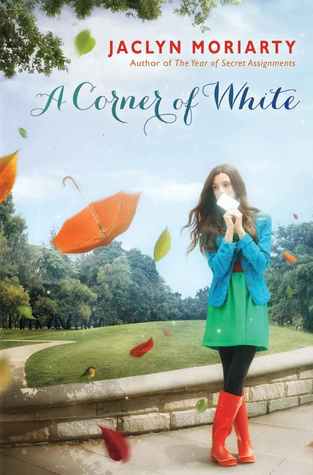Jaclyn Moriarty is one of the few writers, who, when a new
book of hers is released, I go to the bookstore that day and read the book
within the first twenty-four hours of picking it up. A Corner of White, the first book in The Colors of Madeleine trilogy, was released in Canada on April 1,
although it’s taken me a while to sit down and write a review of it. It
introduces two characters, Madeleine and Elliot, who live parallel to one
another: Madeleine in Cambridge, England and Elliot in the fantastical Kingdom
of Cello, in the Farms (Moriarty provides a brief travel guide to Cello at the
beginning of the book, which describes the farms by stating, “Blahdy, blahdy,
hooray for Farmers! Blah, blah, pumpkin pie! etc. Seriously, though, if you’re
short on time, give the Farms a miss”). Although Cambridge exists in a present
context that readers will be familiar with, the Kingdom of Cello is something
much different. Although the characters live out an existence that seems as
contemporary as Madeleine’s Cambridge (there are TVs and radios and advanced
warning systems in Elliot’s town), there is something that seems more timeless,
and unique, about Cello. At the time Elliot’s story is set in, the two
princesses of Cello are touring the kingdom, stopping off in each town to meet
with their subjects. And then there is the fact that there are colors – Red,
Yellow, Blue, Green, etc. – that attack and affect the people who live in the
kingdom. It is an interesting variation on a fantastical setting, and one that
is explored in interesting ways throughout (for example, what the color Red
would be capable of doing plays along with color/word associations in neat
ways).
Although Madeleine and Elliot’s stories seem separate, they
are brought together by a crack in a parking meter in Cambridge that
corresponds to a crack in a sculpture in Cello. Through that crack, Elliot and
Madeleine are able to exchange a series of letters and notes that are
interspersed throughout the book. For me, Moriarty’s books have always been
about the multiple forms of communication that she uses to tell a story. Rarely
does she use a third-person narrative that is present in A Corner of White. Instead, she typically uses letters, journal
entries, notes left on the kitchen counter, and transcripts to tell, and
sometimes supplement, a story. These innovations are present in A Corner of White –letters, newspaper
editorials, and excerpts from the Cello travel guide appear throughout – but
they don’t form the entirety of the story as much as they usually do. I missed
this for a good chunk of the book – probably the first half – but then was able
to take A Corner of White for what it
was instead of what I wished it would be. It is a fantasy trilogy that does
require another form of writing than Moriarty’s other books, and it works well
for the story that she imparts. However, I still felt relieved when I
encountered a longer series of letters between Elliot and Madeleine near the
end of the book, where they are included in a volume that seems closer to what
is present in The Year of Secret
Assignments or Feeling Sorry for
Celia.
Moriarty also highlights a series of historical figures who
spent their time in Cambridge, most notably Lord Byron and Isaac Newton. Their
own stories become integral to the fictional characters’ own. As well, both
Madeleine and Elliot are both trying to deal with their family situations,
which have recently been changed dramatically. Madeleine is used to a lavish
life of pent houses and travel with her mom and dad, but when she runs away from
itnone night her mom follows, and the two move to Cambridge leaving Madeleine’s
father behind. Elliot and his mother, however, have been left by Elliot’s
father, although the details of his disappearance are not clear. Elliot
believes he has been taken to the nest of a Purple, and travels across Cello to
try to find him.
A Corner of White was
not the story that I had been expecting, but is instead a trilogy that I am
looking forward to reading to the end. The book ends with the suggestion of a
possible real-life meeting between Madeleine and Elliot (even though Madeleine
spent the majority of the book disbelieving Elliot’s existence, or the world
that he claimed to live in), and I am really looking forward to that (if it
happens!). Moriarty writes teenage relationships so well, whether they are romantic
or just friendships, and there seems to be so much potential for Madeleine and
Elliot (and the other characters!) to continue to explore in the books that are
still to come.





No comments:
Post a Comment